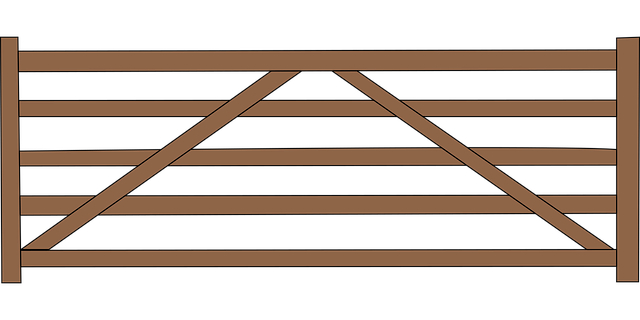In coastal regions, where harsh weather conditions and salt water exposure pose unique challenges, durable wooden fencing is an attractive and sustainable solution. This article delves into the intricacies of designing and installing robust wood fences capable of withstanding coastal environments. We explore the benefits of natural materials, guide readers through selecting suitable wood species, and provide essential installation and maintenance advice to ensure these fences thrive for years. Additionally, we touch on environmental sustainability aspects, highlighting the role of responsible forestry practices in coastal area beautification.
- Understanding Coastal Fencing Challenges
- Advantages of Durable Wooden Fencing
- Choosing the Right Wood Species for Coastlines
- Installation Techniques for Optimal Protection
- Maintenance Tips for Longevity
- Environmental Impact and Sustainability Considerations
Understanding Coastal Fencing Challenges
Coastal areas present unique challenges when it comes to fencing due to their harsh environments. Salt air, strong winds, and regular exposure to moisture can significantly impact traditional fence materials. The challenge is not just about choosing a durable material but also ensuring the fence can withstand extreme weather conditions, such as hurricanes or storms, without compromising aesthetics or structural integrity.
Many common fence materials, including wood, may require frequent maintenance or even replacement in coastal settings. Wooden fencing, for instance, can rot or attract pests like termites when left unprotected. However, durable, treated wooden fencing offers a sustainable and aesthetically pleasing alternative. By utilizing weather-resistant treatments and specific types of wood, such as cedar or treated pine, homeowners and property managers can create long-lasting fences that enhance coastal landscapes while withstanding the elements.
Advantages of Durable Wooden Fencing
Durable wooden fencing offers a range of advantages for coastal areas, where traditional materials might struggle. First and foremost, its natural resistance to corrosion makes it an ideal choice for environments with high moisture levels and salt air exposure. Unlike metal or vinyl fences, wood can withstand these conditions without losing structural integrity or aesthetics over time.
Additionally, wooden fencing provides excellent privacy and security while seamlessly blending into coastal landscapes. Its versatility allows for a variety of styles, from traditional picket fences to elegant, tall wooden walls, catering to different preferences and needs. This durability and aesthetic appeal make durable wooden fencing a sustainable and long-lasting solution for homes and businesses in coastal regions.
Choosing the Right Wood Species for Coastlines
When selecting wood for coastal fencing, understanding the environment is key. Salty air, moisture, and regular exposure to sun and rain can quickly deteriorate ordinary woods. For durability, opt for species naturally resistant to decay and weather extremes like cedar, redwood, or treated pine. These options not only withstand coastal conditions but also offer a longer lifespan compared to softer woods. Additionally, their natural oils repulse water, helping to prevent warping and rot.
Installation Techniques for Optimal Protection
When installing wooden fencing in coastal areas, proper techniques are essential to ensure optimal protection against harsh environmental conditions. One effective method is pre-treating the wood before installation. This involves applying a robust water-repellent or preservative to the fence posts and boards, treating them for rot and insect damage. Treated wood can last up to 50 years, significantly outperforming untreated options.
During installation, it’s crucial to ensure proper drainage around the fencing. This can be achieved by sloping the ground away from the fence and installing a robust drain system. Additionally, using concrete anchors and posts that are at least 3 feet above the predicted flood levels provides extra security against storm surges and high tides. These techniques, combined with regular maintenance, will extend the life of your durable wooden fencing, ensuring it stands strong against coastal elements.
Maintenance Tips for Longevity
To ensure your durable wooden fencing stands the test of time, especially in coastal areas where it faces constant exposure to salt air and moisture, proper maintenance is key. Regular cleaning is essential; brush away debris and use a mild soap or water solution to remove any dirt or algae buildup. This simple step prevents stagnation and maintains the fence’s aesthetic appeal.
Additionally, applying a fresh coat of water-repellent sealer or paint every few years will shield the wood from the elements. These protective layers fill in cracks, prevent rot, and ward off pest damage. Always use products specifically formulated for outdoor, marine environments to ensure longevity.
Environmental Impact and Sustainability Considerations
When considering fencing options for coastal areas, it’s crucial to balance aesthetics with durability and environmental impact. Wooden fences, especially those made from durable species like cedar or treated timber, offer a sustainable choice. These materials are renewable resources that can withstand the harsh coastal climate, reducing the need for frequent replacements. Moreover, proper treatment methods, such as using eco-friendly preservatives, minimize the use of harmful chemicals, ensuring a healthier environment for both residents and wildlife.
The long-term benefits of durable wooden fencing extend beyond its structural integrity. By choosing sustainable options, homeowners contribute to preserving local ecosystems. Traditional wood treatments, when done responsibly, can significantly reduce the environmental footprint compared to alternative materials that might be more toxic or non-biodegradable. This consideration is vital for coastal communities, where the delicate balance of natural habitats is a precious asset.
